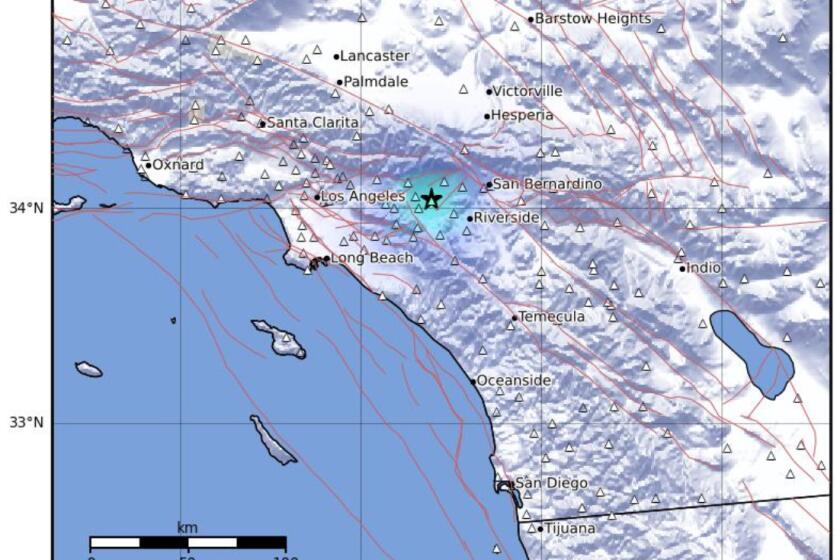Swarm of Quakes Triggers Alert in Central State
Federal and state authorities issued their highest earthquake alert Sunday for a seven-county area surrounding the Central California hamlet of Parkfield, warning there is “about a one-in-three chance” of a strong magnitude 6 quake occurring on the San Andreas Fault by early Wednesday.
It was only the second time in California’s eight-year experiment with formal earthquake predictions that a level “A” alert has been issued. Authorities said there is little chance of a Central California quake strong enough to affect the Los Angeles metropolitan area.
The counties alerted Sunday are Monterey, Fresno, Kings, San Benito, Kern, San Luis Obispo and Santa Barbara. Under arrangements worked out by a state earthquake prediction council, local emergency officials are supposed to take short-term safety precautions of their choosing.
A similar level “A” warning was issued in October, 1992, after a moderate earthquake in the same location. The warning process is part of an earthquake prediction experiment that was begun after forecasts by scientists that there was a 95% chance of a magnitude 6 temblor occurring along the Parkfield segment of the San Andreas between 1985 and the start of 1993. Both the 72-hour alert period and the beginning of 1993 passed without such a quake happening.
The U.S. Geological Survey and the state Office of Emergency Services issued the new 72-hour alert Sunday after a 4:25 a.m. magnitude 4.8 temblor on Middle Mountain, five miles northwest of Parkfield.
The moderate shock, which caused no damage or injuries, was part of a swarm of about 25 earthquakes of lesser magnitude that began Saturday afternoon.
Middle Mountain lies in what is one of the most frequently active segments of the San Andreas. Similar moderate quakes there preceded the last two magnitude 6 earthquakes at Parkfield, in 1934 and 1966. The 1934 quake had two magnitude 5 foreshocks, 55 hours and then 17 minutes before the major quake; the 1966 quake had a similar foreshock 17 minutes before.
A magnitude 6 earthquake in Parkfield, which is about 180 miles from Los Angeles, would at the most only be weakly felt in the metropolitan area.
Pat Jorgenson, a spokeswoman for the Geological Survey, said there was a small chance of a major 7 magnitude quake occurring. Scientists also noted that the great magnitude 8 Ft. Tejon quake in 1857 was preceded by activity in the Parkfield area. Such big jolts would be strongly felt in parts of Southern California.
The officials gave no percentage figure for the chances of an earthquake greater than magnitude 6 occurring in Parkfield. Late Sunday, geophysicist John Langbein, who is in charge of the Parkfield experiment, called the odds of a quake bigger than magnitude 6 “pretty low.”
Although the predicted 1985-to-early-1993 window for a strong Parkfield earthquake has expired, such a quake is still believed inevitable, and state and federal agencies have kept instruments and a monitoring station in Parkfield this year.
However, Jorgenson said no money has yet been budgeted beyond this year to continue the experiment, which has cost about $20 million.
Scientists challenged by the frustrating problem of earthquake prediction have long thought that the sparsely populated Parkfield area is a fertile field for studying events that precede sizable earthquakes.
Quakes between magnitude 5.5 and 6.3 have occurred there in 1857, 1881, 1901, 1922, 1934 and 1966, causing no fatalities and little damage. The 25-mile-long segment of the San Andreas Fault is just north of other so-called “locked” segments, where there have been no significant earthquakes since 1857.
State emergency officials expressed gratification last year at the smooth functioning of emergency preparations in each of the seven counties alerted at that time. In January they announced plans for similar kinds of “imminent earthquake alerts” in Southern California should a magnitude 6 earthquake occur on the southern segments of the San Andreas.
The director of the Office of Emergency Services, Richard Andrews, said in January that an “A” alert would be issued automatically for a magnitude 7 or greater temblor if a magnitude 6 were to occur directly on the San Andreas Fault south and east of San Bernardino.
But state officials have backed off suggestions that they require the cities and counties affected to take specific actions--such as closing schools, evacuating downtown areas or closing businesses--as a result of the alert.
There has never been a decision in California to take such actions based on an earthquake warning, and officials have expressed a fear of a “cry wolf” syndrome if they issue a number of alerts and nothing happens.
Quake Alert
An “A” earthquake alert, the highest level, has been issued for seven counties surrounding the town of Parkfield. The alert, based on a 4.8 jolt at 4:25 a.m. Sunday near the town and a swarm of about 25 lesser quakes that began at 1 p.m. Saturday, warns of a 33% chance of a magnitude 6 earthquake occurring within 72 hours of the Sunday morning temblor. Counties on alert are Monterey, Fresno, Kern, Kings, San Benito, Santa Barbara and San Luis Obispo.
More to Read
Sign up for Essential California
The most important California stories and recommendations in your inbox every morning.
You may occasionally receive promotional content from the Los Angeles Times.










